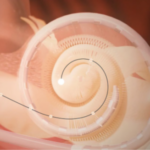- Approximately 5 minutes to read
- Learning objectives:
- Understanding what ESRT measurements are
- Understanding ESRT clinical applications and correlations
- Understanding how to optimize ESRT measurements
Electrical Evoked Stapedius Reflex Thresholds (ESRT) can be used as an objective measure for cochlear implant programming when clinically appropriate. Studies support the use of postoperative ESRTs for MAP verification ¹˒²˒³˒⁴˒⁵. Cochlear suggests using ESRT in conjunction with behavioral loudness scaling to ascertain upper stimulation levels.
What are ESRT measurements?
The stapedius reflex serves as a protective mechanism for the inner ear against excessively loud and potentially harmful sounds. In individuals with normal hearing, this reflex is activated by sound pressure levels (SPL) ranging from 70 to 90 dB SPL. Exposure to a loud noise causes the stapedius muscles in both ears to contract. This contraction moves the anterior stapes away from the oval window and increases the rigidity of the ossicular chain, thereby reducing the amount of vibrational energy reaching the cochlea.
ESRT is the minimal level of electrical stimulation necessary to induce a stapedius muscle contraction, which can be detected through middle ear measurements, such as acoustic admittance, or visually. It is typically measured post-operatively but can also be assessed intra-operatively.
How do we use this information clinically?
Post-operative ESRTs are estimated to be present in approximately 70% to 80% of implant users. ¹˒⁵˒⁶˒⁷ Examining research dating back to 1988 reveals several studies that demonstrate a strong correlation between C levels and ESRT.⁸ Additional research indicates a robust relationship between ESRT and upper stimulation levels ¹˒²˒⁶ and that ESRT measurements typically align with, or are slightly higher than, patients’ psychophysical assessments of upper stimulation levels. ⁶˒⁹˒¹⁰
What factors to consider to ensure optimal ESRT outcomes?
Ipsilateral ESRT measurements are possible; however, our programming guides generally advise to start with the contralateral ear due to the typical absence of responses following cochlear implant surgery, which may effect immittance of the middle ear system. Nonetheless, if there is no response in the contralateral ear, an ipsilateral measurement can be considered. Another consideration to help with the success of obtaining ESRT measurements is to consider changing the probe tone frequency or starting with a higher probe tone (226 Hz, 678 Hz, 1000 Hz).¹¹
Some tips and tricks for ESRT include:
- Ensuring a properly fit probe tip. The probe tip must maintain a proper seal without assistance from the clinician. Adjust the probe tip size as necessary. For a proper seal, Otoferm may be used. The probe tip should keep a seal without manual assistance.
- To address hyper-compliance, increase the probe tone. Apply positive pressure manually to stabilize the tympanic membrane, up to +50 daPa.
- ESRT measurements are also sensitive to conditions such as middle ear disease or obstructions and necessitate a quiet and still patient. Moreover, the relationship between intraoperative ESRT, postoperative ESRT, and C-levels requires further investigation.¹²
What additional resources are available for ESRT measures?
ESRT is a valuable tool for cochlear implant audiologists, especially when combined with behavioral loudness scaling to set upper comfort levels. It can be extremely useful in situations when programming for individuals who are unable to provide reliable psychophysical loudness judgments. For guidance on conducting ESRT measures, detailed instructions are available, including the necessary equipment, protocol setup, and test procedures here:
- Hodges, A., Balkany, T., Ruth, R., Lambert, P., Dolan-Ash, S., & Schloff man, J. (1997). Electrical middle ear muscle refl ex: Use in cochlear implant programming. Otolaryngology—Head & Neck Surgery, 117(3 Pt 1), 255–261. 3. 3
- Jerger, J., Fifer, R., Jenkins, H., & Mecklenberg, D. (1986). Stapedius refl ex to electrical stimulation in a patient with a cochlear implant. Annals of Otology, Rhinology, & Laryngology, 95, 151–157. 4. 4
- Messersmith, J., Entwisle, L., & Stout, A. (2002). Electrically evoked stapedial refl ex threshold: A procedure. Perspectives of the ASHA Special Interest Groups, 9(3), 4-11. 5. 6
- Rene Gifford, Ph.D., Maximizing Performance in Cochlear Implant Recipients: Programming Concepts NYU, December 5, 2022 2. 8
- Wolfe, J., & Kasulis, H. (2008). Relationships among objective measures and speech perception in adult users of the HiResolution Bionic Ear. Cochlear Implants International, 9(2), 70–81. 11
- Spivak, L.G., Chute, P.M., Popp, A.L. & Parisier S. C. (1994). Programming the cochlear implant based on electrical acoustic reflex thresholds: patient performance. Laryngoscope, 104(10), 1225-1230. 9
- Van Den Abbeele, T., Noël-Petroff, N., Akin, I., Caner, G., Olgun, L., Guiraud, J., . . . Arnold, L. (2012). Multicentre investigation on electrically evoked compound action potential and stapedius reflex: How do these objective measures relate to implant programming parameters? Cochlear Implants International, 13(1), 26–34. 10
- Jerger J, Oliver TA, Chmiel RA. (1988). Prediction of dynamic range from stapedius reflex in cochlear implant patients. Ear Hear, 9, 4–8. 5
- Han, D., Chen, X., Zhao, X., Kong, Y., Li, Y., & Liu, S. (2005). Comparisons between neural response imaging thresholds, electrically evoked auditory reflex thresholds and most comfortable loudness levels in CII Bionic Ear users with HiResolution sound processing strategies. Acta Oto-Laryngologica, 125, 732–735. 2
- Pitt, C., Munoz, K., Schwartz, S., & Kunz, J. (2020). The long-term stability of the electrical stapedial refl ex threshold. Otology & Neurotology, 42, 188-196. 6. Wolfe, J., & Kasulis, H. (2008) 7
- Wolfe, J., Gilbert, M., Schafer, E., Litvak L.M., Spahr A.J., Saoji A., Finley C. (2017). Optimizations for the Electrically-Evoked Stapedial Reflex Threshold Measurement in Cochlear Implant Recipients. Ear Hear, 38(2), 255-261. 12
- Caner, G., Olgun, L., Gultekin, G., & Balaban, M. (2007). Optimizing fitting in children using objective measures such as neural response imaging and electrically evoked stapedial reflex threshold. Otology & Neurotology, 28, 637–640. 1


